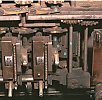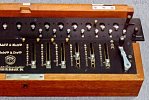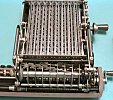The first four function mechanical calculator was made by Gottfried Leibniz in 1694. His design was the first to use the stepped drum mechanism which remained in use for more than two centuries. Due to the accuracy needed in construction, such machines didn't become commercially feasible until the mid-1800s. They generally performed addition and subtraction directly and performed multiplication and division with a little help from the user. They usually had a set of levers or keys to input a number, a result indicator where the results of addition and subtraction appeared and a revolution counter which could count the number of items added (or the number of times a number was multiplied/divided.)
Multiplications and divisions are just repeated additions and subtractions. The machines usually relied on the user to shift the results carriage for each position of one of the factors to multiply. For example, to multiply a number by 125, the user would enter the number and turn the crank 5 times, shift the carriage into the 10s position, crank 2 times, shift the carriage into the hundreds position and crank once to yield an answer. Since the other factor, remained set on the keys or levers during this operation, it was really quite quick and error-free. As a double check, the user could read the first number from the setting levers and read the second number from the revolution counter after the multiply. (The revolution counter was shifted in powers of tens along with the result register.)
To divide, the user entered the dividend (shifted far enough to the left to produce the number of digits needed in the result.) The divisor was then entered and the carriage was set as high as possible such that the divisor could be subtracted and leave a positive result. The user made sure the crank was in the subtractive mode and then turned until the divisor could be subtracted no more. Then the user shifted the carriage down a position (power of ten) and repeated the process producing as many digits as needed. The result was then read from the revolution counter. (Alternately, the user could build up the number to be divided from successive additions of the divisor.) As with slide rules, some thought was required to position the decimal point.
Early models used levers or knobs to set the input numbers. These levers were slid along slots to align with the numbers. (Some including the Curtas, Marchants and TIMs had levers with windows that showed the digits entered. This made checking the numbers easier.) Some later models like the Monroes replaced the levers with keys. Almost all early models used either the pinwheel or stepped drum mechanism.
The large TIM (Time Is Money) calculator shown below was based on the stepped drum calculator mechanism. This was the first type of four function calculator and these machines were inherently large and heavy. (The model shown was 21.5" x 7" x 6" and weighed 23 pounds.)
The first stepped drum calculators were made in wooden boxes (see the Burkhardt below), but the model shown was an improved metal-cased model that was made in 1909. Because of their bulk, sales of these early machines were relatively small. (Dozens to hundreds per year.) Price was another obstacle. In today's dollars, a TIM would be priced at well over $10,000.
The crank on the right was always turned the same way. Whether it performed addition or subtraction depended on the setting of the lever on the far left. (The add/subtract lever caused more than 20 gears across the entire width of the machine to shift position and required some effort to move.)
The sliding levers in the middle set the number to be added and these had windows next to them to show the number at a glance. The little levers in front of the number levers were another "modern" improvement which allowed for quick clearing. Lifting one of these levers set all numbers to the right of that lever to zero. Depressing one of them set all numbers to the left to zero.
The 9 small windows along the bottom right of the brass carriage showed the revolution count. (I.e. one of the multiplicands or the result of a division appeared there.)
Results of addition, subtraction and multiplication could be read from the windows across the top of the brass carriage. All of the numbers across the top of the carriage were part of the 16 digit result register. There was no significance to the user that the numbers on the right were set in larger/deeper windows. (This was done only to allow room for the row of revolution counter digits on the lower right side of the carriage.)
The small knobs below each result window allowed numbers to be entered directly into the windows above them. (This could be handy for a division, for example, since adding the dividend on a conventional machine also left a 1 in the counter which needed to be cleared before subtraction began. It also saved the effort of switching from add to subtract mode in this case.) The two levers on the right side of the carriage cleared the result and counter registers.

|
Picture of a TIM stepped drum calculator |

|
Interior view. This picture shows a portion of the mechanism for a single digit. The stepped drum is the most prominent feature (labeled D). The square shaft (S) that the counter wheel (C) is slid along is above and to the left of the drum. The counter wheel is moved by the lever (L). The part (M) is part of the carry mechanism. Part of the revolution counter is labeled R. |

|
Inside the TIM carriage. This picture shows a small section of the TIM carriage from the bottom. In the center is a result digit wheel with two counter wheels flanking it. |
Burkhardt designed his first calculator in 1878. It was based on the stepped drum design and is credited with laying the foundation of the German calculator industry. (Although during the early years, demand was so small that Burkhardt had to manufacture other products to remain in business.)
This Arithmometer is one of Burkhardt's early models. Operation is similar to the TIM above. The crank is always turned the same way with addition or subtraction selected by the lever on the left. The smaller windows on the carriage count revolutions and the larger windows show totals. Being an older design than the TIM, it lacked some of the conveniences like digit wheels connected to the input slides and input clear levers. (The museum is looking for manuals, or other documentation for this calculator as well as information on the company.)

|
Picture of the Burkhardt Arithmometor |
Odhner was one of the two inventors of the pinwheel calculator in 1874. The picture below is one of his own company's machines. (Many other companies made Odhner style machines.) The machine pictured dates to around 1920.
The large crank on the right was turned forward (clockwise) for addition and in the opposite direction for subtraction. The number to add was entered with the levers on the top and the results appeared in the larger windows on the right of the carriage below. The smaller windows on the left of the carriage counted the number of turns of the main crank.
The smaller crank on the right of the carriage cleared the results windows and the crank on left cleared the turn counter. The two buttons in front of the carriage made it step one digit to the left or right. The levers below the buttons allowed the carriage to move freely in either direction.

|
Picture of an Original Odhner pinwheel calculator laying on its base with the cover behind it. |
This Marchant model improved on the original Odhner pinwheel design by adding a register on top that showed the setting of the input levers at a glance. The controls were the same as the Odhner with the addition of a crank to clear the additional number register. (In case they got out of sync with the levers.) Marchant started making pinwheel calculators in 1911. Marchant advertised these models as 'the last word in calculators.' HP suggested that the HP 9100A might be the 'first word' in a new breed of calculators.

|
Picture of a Marchant pinwheel calculator on its base. |
While pinwheel and stepped drum machines were excellent for multiplication and division, the adding machine was better for addition and subtraction. The keyboards of adding machines made for faster data entry than the levers of the pinwheel and stepped drum machines. A number of companies designed machines which combined the advantages of each type. They had keyboards for fast data entry but and shiftable carriages for easy multiplication and division.
Monroe was one of the earlier companies to design such a calculator in 1911 using a new mechanism. (The design was done by Frank Baldwin who previously invented the pinwheel calculator.)
The model shown had a full keyboard for numeric entry. The crank on the front shifted the carriage back and forth. The large crank on the side performed addition and subtraction depending on which direction it was turned and the smaller crank on the carriage zeroed the registers. (Which register was zeroed was determined by the direction the crank was turned.)
Like adding machines, this machine could clear the input digits on each addition. The numbers were cleared if the R (repeat) button was not down. (The blank button raised the repeat button.) The large 0 button in the lower right cleared the entire keyboard. Individual digits could be cleared by pressing the blank keys in each column. The small model shown was made in 1953.

|
Picture of a Monroe keyboard calculator (non-electric) |

|
Interior of the Monroe. In the picture, part of the keyboard setting mechanism is shown in the top/center. The large wheels at the bottom center are part of the carry mechanism. Each of the small spring-loaded paddles on the wheels could slide over to add one to the next counting wheel. One of the counting wheels can be seen on the bottom left. |

|
Interior from a different angle. |
This calculator used the rocking segment mechanism commonly found in ten key adding machines but in this calculator it was adapted to all four functions. Numbers were added as on a normal ten key machine using the large operation button. To subtract, the number was entered (with no need for complementary digits) and the subtract key was pressed. Then the large button was pushed, and the calculator disengaged and reengaged the counter wheels such that they turned in the opposite direction. (This also had the rather odd effect of shifting the carriage to the left under the plastic window.) Unlike the counter wheels typically found in adding machines, these were mounted at a right angle to the segments and by the shifting the counters left or right, the segments would drive the wheels on one side or the other.
Multiplication and division was aided by the ← and → keys which shifted the number entered. This was actually a rather simple mechanism since the <- had nearly the same effect as pressing the 0 key and the -> key had the same effect as a backspace key. To multiply, one number was entered and the large button was pressed the number of times in the least significant digit of the other number. Then the appropriate shift key was pressed (which shifted the input number rather than the result register) and the user continued.
Division was like other four function machines with an additional aid. The user could simply press the large button until it locked. The calculator automatically subtracted until the subtraction underflowed and on the next press of the button, it added the number back and then locked the large button. The user could then press the shift key to unlock the machine and continue. Another nice feature was the division shift key. This key shifted any number entered as far left as possible in order to allow maximum precision during divisions. The machine did have one limitation however: The counter was a single digit. This meant that you couldn't check a multiplication after you were finished and you needed to write down the counter at each digit during division. (The locking button helped to remind you.) The machine shown was made in the 1960's.

|
Picture of a Bohn Context calculator.(The single digit counter is surrounded in gray - the results counter digits are surrounded by white.) |
![]() Back to early models contents
Back to early models contents
![]() Go on to the motor driven models
Go on to the motor driven models
![]() Back to the four function models
Back to the four function models